Walt Disney’s only record album for his in-house record company, the first it produced and released, sixty-five years ago.

WALT DISNEY TAKES YOU TO DISNEYLAND
A Musical Tour of the Magic Kingdom
Narrated by Walt Disney
With the Disneyland Concert Orchestra
Disneyland Records WDL-4004 (12” 33 1/3 RPM LP with Book / Mono)
(Also released on 45 rpm extended play records)
Released on May 1, 1956. Producer: Jimmy Johnson. Arranger/Conductors: Tutti Camarata, Oliver Wallace, George Bruns. Running Time: 36 minutes.
Vinyl Reissues: “A Day at Disneyland” (Revised with Jiminy Cricket) ST-3901 (1957);
“A Musical History of Disneyland” (Vinyl Reproduction included with CD Box Set, #61283-2 (2005)
CD Reissue: #61346-7 (2007)
Currently available on various streaming services
Music: “Overture: Disneyland Theme”, “Adventureland Suite (Adventureland Boat Ride / Orchids in the Jungle / Monkeys and Hippos / Distant Drums / The River and the Rapids / Tribal Dances / Finale)” by Camarata; “Meet Me Down on Main Street” by Oliver Wallace; “Westward Ho the Wagons”, “The Ballad of Davy Crockett” by Tom Blackburn, George Bruns; “Old Betsy” by George Bruns, Gil George; “Slue Foot Sue’s Hoedown”, “Tomorrowland Suite (Overture / The World of Tomorrow / Countdown and Blast Off / Outer Space / A Meteorite Strikes / The Other Side of the Moon and Back / Next Target: Mars)” by George Bruns; “Farewell” by Davy Crockett, George Bruns; “Whistle While You Work”, “Someday My Prince Will Come”, “Heigh-Ho” by Larry Morey, Frank Churchill; “You Can Fly! You Can Fly! You Can Fly!” by Sammy Fain, Sammy Cahn; “Alice in Wonderland” by Bob Hilliard, Sammy Fain; “When You Wish Upon a Star” by Ned Washington, Leigh Harline.
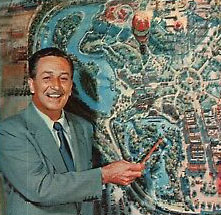 Before the Spring of 1956, The Walt Disney Studios did not have its own record company. Instead, the major labels such as Columbia, RCA, Decca and Capitol (as well as smaller independent labels) produced, advertised and distributed all the recordings featuring Disney films, characters, songs and stories. The studio creative staff sometimes participated in creating the audio and/or illustrated materials for the licensees.
Before the Spring of 1956, The Walt Disney Studios did not have its own record company. Instead, the major labels such as Columbia, RCA, Decca and Capitol (as well as smaller independent labels) produced, advertised and distributed all the recordings featuring Disney films, characters, songs and stories. The studio creative staff sometimes participated in creating the audio and/or illustrated materials for the licensees.
It took several years for Disney Legend Jimmy Johnson to convince Roy O. Disney, in particular, to bring the operation inside the gates. Taking on such an operation would incur considerable costs and would take a long time to show a profit. Johnson was determined to prove the worthiness of such an investment.
Johnson, who details this and many more fascinating behind-the-scenes facts in his autobiography, Inside the Whimsy-Works: My Life with Walt Disney Productions, which I edited with Didier Ghez, had already established The Walt Disney Music Company in the Fall of 1949. He had already provided evidence for establishing in-house music operations when Cinderella, the first animated feature with a Disney-owned score, became a huge hit and brought all that music publishing success directly to Disney.
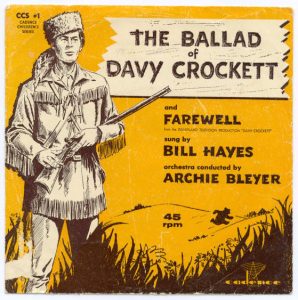 This was not the case with earlier Disney songs and scores owned by other publishers because Disney did not have its own music division. Once The Walt Disney Music Company began, Johnson acted on behalf of Roy to renegotiated the music rights and repurchased almost everything. Some deals took decades. The only holdout to this day is the Bourne company, which continues to own publishing rights to several Silly Symphonies as well as the songs and scores for Dumbo, Pinocchio and Snow White and the Seven Dwarfs.
This was not the case with earlier Disney songs and scores owned by other publishers because Disney did not have its own music division. Once The Walt Disney Music Company began, Johnson acted on behalf of Roy to renegotiated the music rights and repurchased almost everything. Some deals took decades. The only holdout to this day is the Bourne company, which continues to own publishing rights to several Silly Symphonies as well as the songs and scores for Dumbo, Pinocchio and Snow White and the Seven Dwarfs.
Johnson insisted that, like music rights, it was important to keep as much of the recorded product in-house as possible. In 1950, RCA’s Little Nipper book and record set of Cinderella sold over 750,000 copies and was the number-one recording on the Billboard pop charts (and this was not just the children’s list). In 1955, “The Ballad of Davy Crockett” became a long-standing number one smash for Bill Hayes on the small Cadence label. Even Fess Parker was frustrated because his version on Columbia did not chart as high, his version was being handled at the much bigger Columbia label, which could not turn a product around as quickly as Cadence, which got to stations and stores faster.
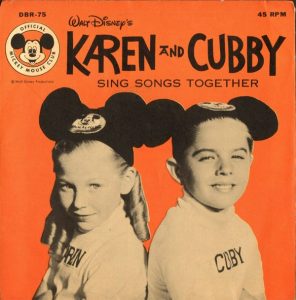 It was the Mickey Mouse Club phenomenon that finally gave Johnson the edge to convince Roy that they needed their own record company. Even though the first MMC recordings were produced by Disney, they were initially manufactured and distributed by ABC’s Am-Par Records (10-inch 78’s and 7-inch 45’s) and by Little Golden Records (6” 78’s that sold in the millions for twenty-five cents each). A lot of revenue was going elsewhere fast.
It was the Mickey Mouse Club phenomenon that finally gave Johnson the edge to convince Roy that they needed their own record company. Even though the first MMC recordings were produced by Disney, they were initially manufactured and distributed by ABC’s Am-Par Records (10-inch 78’s and 7-inch 45’s) and by Little Golden Records (6” 78’s that sold in the millions for twenty-five cents each). A lot of revenue was going elsewhere fast.
When the first albums in the new Disneyland Records line hit stores on May 1956, they included a selection of classic soundtracks produced by Disneyland Records musical director Tutti Camarata, who presented them in an album format never experienced before, from original master film tracks. These were all culled from earlier studio materials, only one album was a premiere release.
That album was Walt Disney Takes You To Disneyland, the very first album completely produced and marketed by Jimmy Johnson and the staff of Disney’s fledgling in-house record division. Created especially for records, it was a brand-new original spoken word and musical production by Walt himself. It was also the only record he ever recorded for the label bearing his name (although his Mickey Mouse character voice popped up on a number of discs, accessed from film soundtracks).
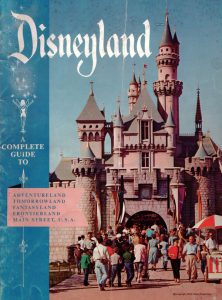 Walt’s narration takes up only a fraction of the entire recording. The back cover more accurately describes it as “A Musical Tour of the Magic Kingdom” and the vinyl label itself calls the album “A Musical Tour of Disneyland,” so take your pick. The disc is a collection of four fully orchestrated suites by three of Disney’s greatest musical directors, each devoted to one of the four lands of Disneyland when it opened in 1955.
Walt’s narration takes up only a fraction of the entire recording. The back cover more accurately describes it as “A Musical Tour of the Magic Kingdom” and the vinyl label itself calls the album “A Musical Tour of Disneyland,” so take your pick. The disc is a collection of four fully orchestrated suites by three of Disney’s greatest musical directors, each devoted to one of the four lands of Disneyland when it opened in 1955.
Walt speaks briefly at the start of each “land” section. An overture, composed by Tutti Camarata, opens the LP, followed by Walt reading a few words from the dedication plaque (“To all who enter this happy place…”) and describes Main Street, U.S.A.
Walt offers slightly more detail about Main Street than he does for any of the other lands represented on the record. This may be no accident; nor is his mention of the Music Store, which was the brainchild of Jimmy Johnson. The Wonderland Music Store was Johnson’s pride and joy. He personally supervised every inch, doing some of the labor himself, lovingly acquiring the player piano and music rolls, etc. Walt Disney Records producer and historian Randy Thornton paid tribute to Johnson and the location by naming the 2010 Disney Parks direct-to-disc CD system after the store.
A few sound effects help create each audio portrait. Oliver Wallace includes his now-beloved “Meet Me Down On Main Street,” which was heard with different lyrics in the 1950 Donald Duck cartoon, Crazy Over Daisy.
This sets up the format of the entire disc: narration, instrumental music, and a sound effect or two here and there. This pure-audio concept sets up the format for the listener, then allows imagination to take over. It is not unlike the experience of Side One of Disneyland Records’ 1964 bestseller, Chilling Thrilling Sounds of the Haunted House, in which Laura Olsher sets up the situations and the sound effects finish out each track.
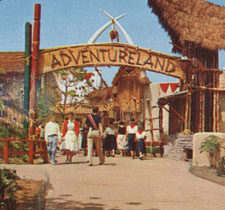 “Adventureland” is a standout track, due in no small part to Camarata’s melodic masterpiece, the “Adventureland Suite.” This Les Baxter/Martin Denny-style tropical jungle tone poem approximates the story pattern of the Jungle Cruise attraction. Not only did this piece of music reappear on other Disneyland records, it also anticipates George Bruns’ evocative main title music for The Jungle Book. It was later used as the background for Skipper Thurl Ravenscroft’s Jungle Cruise narration on this LP and as ideal incidental music for the vinyl sequel album to The Jungle Book with Phil Harris, described in this Spin.
“Adventureland” is a standout track, due in no small part to Camarata’s melodic masterpiece, the “Adventureland Suite.” This Les Baxter/Martin Denny-style tropical jungle tone poem approximates the story pattern of the Jungle Cruise attraction. Not only did this piece of music reappear on other Disneyland records, it also anticipates George Bruns’ evocative main title music for The Jungle Book. It was later used as the background for Skipper Thurl Ravenscroft’s Jungle Cruise narration on this LP and as ideal incidental music for the vinyl sequel album to The Jungle Book with Phil Harris, described in this Spin.
The “Frontierland” portion is an example of the finely honed marketing technique that Roy Disney called “cross-pollination,” the equivalent of today’s “synergy”. In addition to “The Ballad of Davy Crockett”, this track also works in the theme to the then-current Westward Ho the Wagons — a feature film co-starring members of the Mouseketeers with Fess Parker (and even George Reeves of TV’s Adventures of Superman). Westward Ho the Wagons! was also the first live-action soundtrack to originate on Disneyland Records with stunning cover art created just for the album by Peter Ellenshaw.
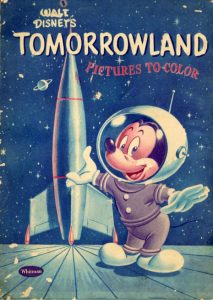 Tying one project in with another was business as usual for the Walt Disney Studios, especially in the 1950s of the Walt era, when the blend of entertainment, education and promotion had become fully honed. The intention was for “Disneyland” to be a living template from which the various company enterprises were generated. Walt explained this interconnectivity in the inaugural episode of his first ABC series. By design, there was Disneyland the place, Disneyland the television show, and now Disneyland the record label.
Tying one project in with another was business as usual for the Walt Disney Studios, especially in the 1950s of the Walt era, when the blend of entertainment, education and promotion had become fully honed. The intention was for “Disneyland” to be a living template from which the various company enterprises were generated. Walt explained this interconnectivity in the inaugural episode of his first ABC series. By design, there was Disneyland the place, Disneyland the television show, and now Disneyland the record label.
The record album’s “Tomorrowland’ sequence is grand fun for fans of mid-20th century sci-fi movies and television, Based on the Rocket to the Moon attraction, this track contains (uncredited) “mission control” dialogue with sound effects and a dramatic original suite by George Bruns that epitomizes the distinctive style of Disney film and TV music of the ‘50s and ‘60s.
Walt Disney Takes You To Disneyland was revised and reissued as a 1957 Storyteller book and record LP called A Day at Disneyland with additional narration over the musical sections by Cliff Edwards as Jiminy Cricket. We detailed that album further in this Spin. As one of our readers, Frederick Weigand notes, the album was recreated, gatefold cover and all, for a magnificent multi-disc CD set celebrating the 50th Anniversary of Disneyland. It was then issued as compact disc itself, with a smaller gatefold cover, a few years later and is available for streaming and download.
“Fantasyland” from Walt Disney Takes You To Disneyland
In the spectacular finale segment. arranger/conductor Camarata includes the opening strains of “When You Wish Upon a Star” just as it was heard at the beginning of Pinocchio, and his unique take on “You Can Fly! You Can Fly! You Can Fly” which he adapted for the Mickey Mouse Club LP, A Walt Disney Song Fest (later released as Walt Disney’s Most Beloved Songs). There was an Animation Spin about that album here.
Here is the album’s center spread (click each to enlarge) and back cover:
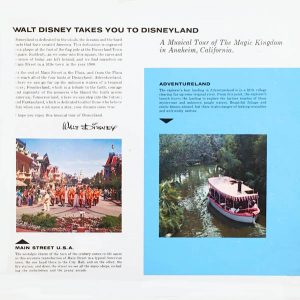
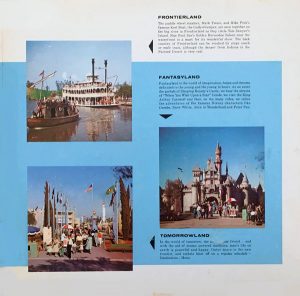
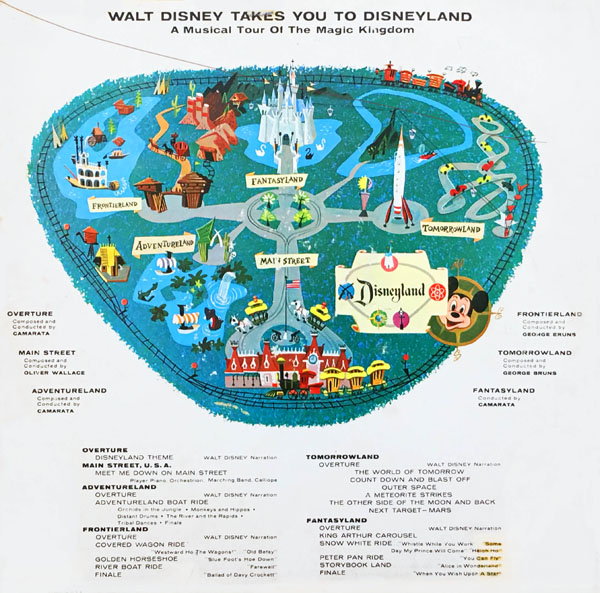
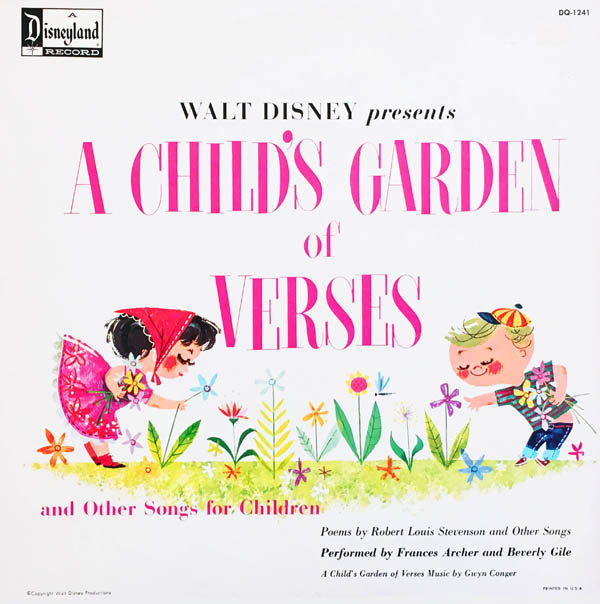
Robert Louis Stevenson’s
A CHILD’S GARDEN OF VERSES
Set to Music by Gwyn Conger
As Performed by Frances Archer and Beverly Gile
From Walt Disney’s Mickey Mouse Club Television Show on ABC-TV
Original 10” LP Release: Chas. H. Hansen Music Corp. (Disneyland logo, no catalog number)
12” LP Reissues: WDL-3004 (late 1956); WDL-1008 (1959); DQ-1241 (Nov. 1964); ST-3802 (Jan. 1971) (Mono)
CD Reissue: DQ-1241 Wonderland Music Store (Disney Parks Exclusive Direct-to-Disc, 2010)
Currently available on various download and streaming services.
Released in 1956. Producer: Jimmy Johnson. Running Time: 31 minutes.
“A Child’s Garden of Verses”: “The Wind,” “Where Go The Boats?” “The Moon,” “From
A Railway Carriage,” “Singing,” “The Swing,” “Looking Glass River,” “Marching Song,” “Land Of Nod,” “Windy Night,” “Block City” by Robert Louis Stevenson, Gwyn Conger.
Other Children’s Songs (all traditional): “Frog Went A-Courtin’,” “Fiddle-De-Dee,” “Riddle Song” (aka ”I Gave My Love”), “Frere Jacques,” “Can Ye Sew Cushions?” “Vogels Hochzeit,” “The Little Nut Tree,” “At The Gate Of Heaven” (translated from Spanish by A.D. Zanzig).
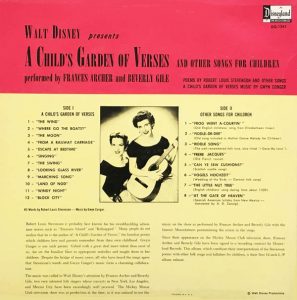 Several months before the Disneyland Records division officially began in May 1956 with the release of Walt Disney Takes You To Disneyland, the Mickey Mouse Club was lighting up TV screens everywhere and the Disney staff was on the lookout for entertainment to present with the Mouseketeers. A talented duo was discovered and made multiple appearances. One of their segments turned out so well that a humble recording was released with a Disneyland Records label—except that it would still be months before there was a “Disneyland Records” company quite yet.
Several months before the Disneyland Records division officially began in May 1956 with the release of Walt Disney Takes You To Disneyland, the Mickey Mouse Club was lighting up TV screens everywhere and the Disney staff was on the lookout for entertainment to present with the Mouseketeers. A talented duo was discovered and made multiple appearances. One of their segments turned out so well that a humble recording was released with a Disneyland Records label—except that it would still be months before there was a “Disneyland Records” company quite yet.
It began when the two performers were selected by Walt Disney himself. Frances Archer and Beverly Gile teamed in 1951 and developed a following during the folk music boom of the mid-20th century. Part of their success was due to the remarkable sonic effects of Archer’s sprightly soprano and Gile’s warm contralto, both separately and in various forms of combination.
Walt Disney saw them perform at a Palm Springs event and enthusiastically recommended them to Jimmy Johnson. Bill Walsh was contacted to give them an audition for the Mickey Mouse Club, as he was the producer (and would go on to co-write and produce Mary Poppins, The Love Bug and Bedknobs and Broomsticks.
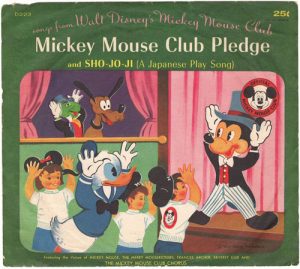 Songs were crucial to the Mickey Mouse Club segments, and an exhaustive number of them were commissioned and acquired in addition to the ones being written by Mouseketeer Jimmie Dodd and the creative staff. For one of Archer and Gile’s TV appearances, they sang one of these acquired international tunes, a Japanese folk song called “Sho-Jo-Ji.” A studio version of the song was made and included on the first Mickey Mouse Club album (see this Spin) and on various Little Golden and Am-Par singles and EP records, which places Archer and Gile at the very beginning of the “Official Mickey Mouse Club Records” label as well.
Songs were crucial to the Mickey Mouse Club segments, and an exhaustive number of them were commissioned and acquired in addition to the ones being written by Mouseketeer Jimmie Dodd and the creative staff. For one of Archer and Gile’s TV appearances, they sang one of these acquired international tunes, a Japanese folk song called “Sho-Jo-Ji.” A studio version of the song was made and included on the first Mickey Mouse Club album (see this Spin) and on various Little Golden and Am-Par singles and EP records, which places Archer and Gile at the very beginning of the “Official Mickey Mouse Club Records” label as well.
For another appearance, Archer and Gile sang musicalized poems from A Child’s Garden of Verses, a classic collection of poetry by Robert Louis Stevenson, author of adventure stories like Treasure Island and Dr. Jekyll and Mr. Hyde. The melodies were written by Gywn Conger, former wife of East of Eden and Of Mice and Men novelist John Steinbeck.
Disneyland Records did not exist as a division when this occurred, though it may have been in the talking stages (as it had been for years). Nevertheless, Jimmy Johnson recorded Archer and Gile performing all the Child’s Garden of Verses tunes along with several other children’s folk songs.
It was pressed as a ten-inch 33 1/3 LP record, not very common today but somewhat popular in the post-WWII era. The photos and text emphasized the Mickey Mouse Club. Since there was no record company and no catalog, there was not even a catalog number on the record. Johnson turned to the trusted music publisher Charles Hansen to print an inexpensive, black-and-white cover with blue spot color and to distribute the record to much the same retailers as his popular sheet music.
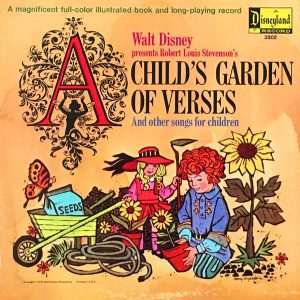 Thus, while A Child’s Garden of Verses had a “Disneyland” label, it was a one-off product created in conjunction with Hansen and Disney, a precursor to a Disneyland Records company just before it started. This album never went out of print until throughout the vinyl era. After the Mickey Mouse Club was winding down, the cover was given a whimsical new design and sold as a single album under several catalog numbers. In 1971, illustrator Harry Wysocki created elaborate images for each of the Stevenson songs and the album was also made available in the Storyteller series. In its gentle way, A Child’s Garden of Verses is a landmark in the story of Walt Disney Records and a sheer delight to this day, still available as a digital stream or download.
Thus, while A Child’s Garden of Verses had a “Disneyland” label, it was a one-off product created in conjunction with Hansen and Disney, a precursor to a Disneyland Records company just before it started. This album never went out of print until throughout the vinyl era. After the Mickey Mouse Club was winding down, the cover was given a whimsical new design and sold as a single album under several catalog numbers. In 1971, illustrator Harry Wysocki created elaborate images for each of the Stevenson songs and the album was also made available in the Storyteller series. In its gentle way, A Child’s Garden of Verses is a landmark in the story of Walt Disney Records and a sheer delight to this day, still available as a digital stream or download.
Archer and Gile enjoyed a few years of fame on TV programs like The Tonight Show. They followed Garden of Verses with several singles and albums including Community Concert and Folk Songs from the Far Corners. The latter was an innovative experimental album in which Camarata combined their voices with orchestrations and his trumpets with American and world music. It is one of only two historic Disney recordings created at the American Legion Hall in Los Angeles, the other being Camarata Conducts the Music of Cinderella and Bambi (please see this Spin).
In the early seventies, Frances Archer and Beverly Gile recorded their last two Disneyland LPs, 12 Short Songs for Young People and Up, Down, All Around, rounding out almost two decades of contributions to the rich musical heritage of the spinning Disney discs.
“Singing” – Frances Archer and Beverly Gile
During the Mickey Mouse Club presentation of A Child’s Garden of Verses, while Archer and Gile sang and played guitar, The Mouseketeers acted out the roles for each of the descriptive lyrics. The photo in the umbrella shape on the original ten-inch LP front cover (pictured below this box) depicts several Mouseketeers acting out the poem, “Singing,” with Roy Williams as “the organ man singing in the rain.”
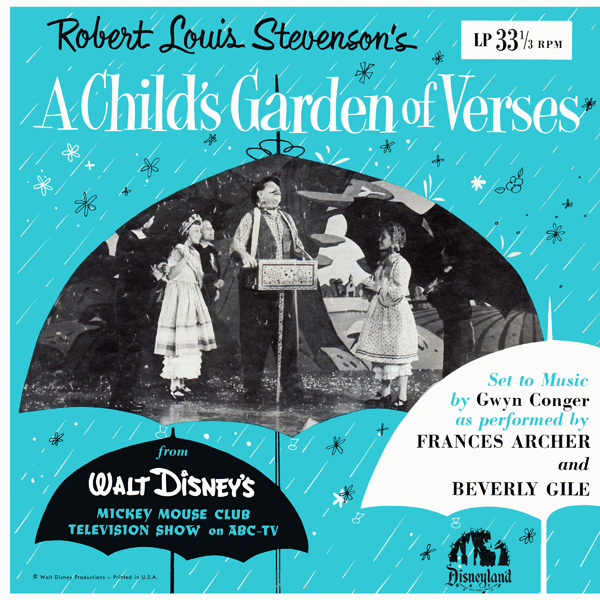
[Portions of this article were previously posted.]


 GREG EHRBAR is a freelance writer/producer for television, advertising, books, theme parks and stage. Greg has worked on content for such studios as Disney, Warner and Universal, with some of Hollywood’s biggest stars. His numerous books include Mouse Tracks: The Story of Walt Disney Records (with Tim Hollis). Visit
GREG EHRBAR is a freelance writer/producer for television, advertising, books, theme parks and stage. Greg has worked on content for such studios as Disney, Warner and Universal, with some of Hollywood’s biggest stars. His numerous books include Mouse Tracks: The Story of Walt Disney Records (with Tim Hollis). Visit 




















































One fascinating aspect of Disneyland Records is that occasionally the records actually represented Disneyland the theme park. Several previous Spins have documented other records that offered tours and other glimpses of various Disneyland attractions. These records were truly “Disneyland Records” in every sense of the word.
I did not find any mention above of the re-release of “Walt Disney Takes You to Disneyland” that was issued in 2005 as part of Disneyland’s 50th anniversary celebration. The record was re-issued on vinyl and it was also made available as a CD in that banner year of 2005. This was actually my first awareness of the existence of this recording. I was, of course, delighted with it. The CD joined my collection of other audio recordings of Disneyland attractions that I had been collecting over the years.
Collecting audio tracks of Disneyland attractions is an adventure all in itself–as much of a one as ever encountered in Adventureland or Frontierland. I believe I have succeeded in gathering as comprehensive a collection as possible for one who is not employed by Disney and has no direct access to archival material. I at least have plenty of representations of the “real” Disneyland–the era when Walt was living and the period immediately following his passing when his dreams were still the guiding principle. “Walt Disney Takes You to Disneyland” was thus a gem among gems for me.
The recordings of Archer and Gile were found on many a Disney records release during the 60’s and into the 70’s. Their style is certainly different and unique from other artists who were performing for Disney during that time. Often the two ladies’ voices are unaccompanied by any instrument, or possibly by a folk guitar. As a child, I found them a bit of a reach–their recordings shared vinyl space with some more “lively” and “robust” numbers featuring the Mouseketeers or a professional chorus–these latter often with full instrumental accompaniment. In such a context, my child-self was less able to appreciate the extraordinary delicacy and charm of the Archer and Gile recordings. Now, of course, I would love to acquire a fresh re-release so that I could savor them in ways that I was unable to do earlier.
Thanks, Greg, for another great post–and a fine tribute to the first two albums out the gate for Disneyland Records.
It’s important that everyone knows that this entertaining and important work is still a current title in the Walt Disney Records catalog and that people can still enjoy it today. We have added the information to the text. Thanks, Frederick!
Agreed that this is another great post from you and certainly deserves wider distribution. Hope you are considering collecting these columns into another book one of these days.
My excitement in getting this record was dampened by the fact that there was so little Walt on it. I suspect that it is so little because Johnson may have written the script so that Walt could record it quickly in one morning or afternoon session. Thanks for the link back to the Jiminy Cricket version. Always look forward to these columns.
Thanks, Jim, kind words indeed. It does sound as if Walt must have recorded it quickly, as this was a rather hectic time for him, I would imagine!
For a classical music lover, listening to a Camerata orchestral suite is sort of like listening to a John Williams film score. Part of the fun is picking out the little bits of classical pieces that have been worked into the score alongside the familiar Disney tunes. (This is by no means a criticism of his work; all composers do it to some degree.) So the Fantasyland Suite calls to mind not only Disneyland, but also “Swan Lake” and “The Nutcracker”. The sequence of chords in the celesta in the introduction and at the very end is strongly reminiscent of the scene in Act II of the opera “Der Rosenkavalier” when Octavian gives Sophie a silver rose as an engagement present from Baron Ochs, even though Octavian is in love with her himself. I guess Camerata just liked that particular magical effect. Well, as far as that goes, who wouldn’t?
I’ve been saying for years that Camarata and John Williams’ musicality are in the same league. People in the industry knew Tutti’s reputation and the positives about his work and about him as a person were in complete sync.
There are definite parallels between Williams’ signature works and what I believe to be one of Tutti’s finest works, and those who know me already know what that album is… Alice in Wonderland with Darlene Gillespie.
“Cross-pollination,” I like that better than “synergy.”
I’ll have to find a copy of that Tour of Disneyland album; it sounds like a nice presentation.
Who in the heck is Darlene Gillespie? Sounds like a butta company.
Seriously Greg, I loved this article and learned a ton. I don’t know much about Giles and would like to know more. I had no idea that George Reeves was in the Westward Ho movie. I’m going to have to check my record to see if he’s credited.
It’s nice to see Korkis weighing in. How are you Jim? What are you doing these days?
Thank you Greg!
Ever the kidder, Tom!
George Reeves does not appear on the Westward Ho album, even though he could sing–and so could Noel (Lois Lane) Neill. They did some live singing appearances together. I wish they had recorded something! The Westward Ho album does have a vocal by Bill Reeve, no relation, a studio singer with a voice similar to that of Bill Lee.
Stacia Martin could not confirm whether the syndicated Mickey Mouse Club episodes included the Archer and Gile appearances. I do not remember ever seeing them myself and I watched the reruns over and over. The shows were edited a lot over the years so the original elements are not easy to pinpoint and/or reassemble. One can see why Jimmy Johnson rushed the MMC-tie-in version of Garden of Verses into stores while that specific appearance was still recent.
Of course, you already know Jim Korkis is our King Friday of The Cartoon Research Land of Make-Believe.